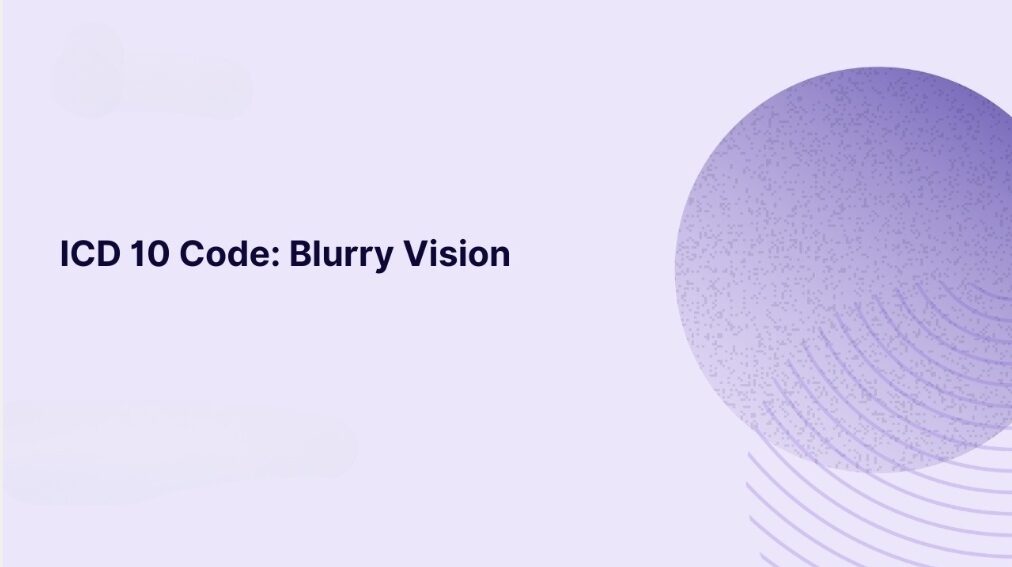Blurred Vision ICD 10 is a common visual symptom characterized by a lack of sharpness in vision and inability to see fine details. Accurately diagnosing and coding blurred vision using the ICD-10 is crucial for effective treatment and healthcare documentation.
What is Blurred Vision ICD-10?
Blurred vision ICD 10 refers to the coding of blurred vision within the ICD-10 classification system. ICD-10, which stands for International Classification of Diseases, 10th Revision, is a coding system used by healthcare professionals to classify and code all diagnoses, symptoms, and procedures.
Blurred vision is commonly coded as H53.8, which is the general code for “Other visual disturbances” in ICD-10. However, depending on the underlying cause and specifics of the condition, a different or more specific ICD-10 code might be used. For instance, if blurred vision is due to a refractive error, it might be classified under a code that specifies the type of refractive error (like myopia or hyperopia).
Common Causes and Associated Symptoms
- Age-related changes: As individuals age, the risk of developing vision issues, such as cataracts, increases.
- Refractive errors: Including myopia (nearsightedness), hyperopia (farsightedness), and astigmatism, which distort visual perception.
- Medical conditions: Diabetes and high blood pressure can lead to vision problems as complications.
- Eye strain: Often caused by prolonged exposure to computer screens or inadequate lighting.
Each of these factors contributes to the overall experience of blurred vision ICD 10, making it a multifaceted issue that requires comprehensive understanding and approach for accurate coding and treatment.
ICD-10 Coding for Blurred Vision

H53.8 Code Overview
- The Blurred Vision ICD 10 code, specifically H53.8, categorizes various unspecified visual disturbances, including blurred vision, within the ICD-10 system.
- Understanding how to accurately apply the H53.8 code is vital for healthcare providers to ensure proper patient documentation and treatment strategies.
How Blurred Vision ICD 10 is Categorized Within the ICD-10 System
- Classification: Blurred vision falls under the broader category of visual disturbances, which are part of the chapter on diseases of the eye and adnexa.
- Subcategories: It is crucial to note that while H53.8 is a nonspecific code, more precise coding might be required based on underlying causes and specific diagnoses.
Causes of Blurred Vision
Medical Conditions Leading to Blurred Vision ICD 10
- Ocular diseases: Conditions like glaucoma and macular degeneration directly affect the eyes’ ability to focus.
- Systemic diseases: Disorders such as multiple sclerosis or stroke can impact vision due to neurological or vascular complications.
- Infections: Eye infections, both viral and bacterial, can cause transient or lasting blurred vision.
Lifestyle Factors
- Diet and nutrition: Deficiencies in essential vitamins and minerals can impair visual health.
- Alcohol and tobacco use: These substances have deleterious effects on eye health and can lead to deterioration of vision quality.
- Environmental factors: Exposure to pollutants and allergens can also contribute to blurred vision.
Diagnosis of Blurred Vision
Diagnostic Procedures
- Visual Acuity Test: Measures the smallest letters a person can read from a specific distance, identifying the clarity or blurred vision ICD 10.
- Refraction Test: Determines the appropriate lens power needed to compensate for any refractive error causing blurred vision.
- Slit-lamp Examination: An intense beam of light is used to examine the front of the eye, including the cornea, iris, and lens.
Role of Healthcare Professionals
- Ophthalmologists: Specialize in eye health, managing both medical and surgical eye care.
- Optometrists: Focus on regular vision care and can diagnose conditions affecting the eyes.
- Primary Care Physicians: Often the first contact for patients with blurry vision, who may then refer them to specialists.
Treatment Options for Blurred Vision
Common Treatments and Interventions
- Prescription Eyewear: Corrective glasses or contact lenses are often the first line of treatment for refractive errors.
- Medications: Used to treat underlying causes such as infections or inflammation.
- Surgery: Procedures like LASIK or cataract surgery can be necessary for long-term correction of blurred vision ICD 10.
Addressing Underlying Causes
- Control of Diabetes and Hypertension: Managing these conditions can significantly improve or stabilize vision.
- Lifestyle Modifications: Including improved diet, increased physical activity, and smoking cessation.
- Regular Eye Examinations: Essential for early detection and treatment of conditions that could lead to blurred vision.
Blurred Vision and Eye Health

Impact on Overall Eye Health
- Chronic Strain: Prolonged blurred vision ICD 10 can lead to additional stress on the eye muscles, potentially worsening the condition or causing other complications.
- Decreased Quality of Life: Impaired vision affects daily activities, reducing independence and overall life satisfaction.
Preventative Measures
- Regular Eye Check-Ups: Essential for early detection of conditions that may lead to blurred vision.
- Protective Eyewear: Using sunglasses or protective glasses to shield eyes from UV rays and debris.
- Healthy Lifestyle Choices: Including maintaining a balanced diet rich in vitamins A, C, and E, which support eye health.
Reporting and Coding Blurred Vision with ICD-10
Best Practices for Coding
- Detailed Patient History: Collect comprehensive information about the patient’s symptoms and health history.
- Accurate Application of H53.8: Ensure blurred vision ICD 10 is used appropriately based on diagnostic findings.
- Continuous Education: Healthcare professionals should stay informed about the latest ICD-10 updates and coding practices.
Examples of Coding in Clinical Practice
- Case Study 1: A patient with diabetes presenting with gradual vision loss might be coded under H53.8 after excluding more specific diagnoses.
- Case Study 2: A young adult with sudden blurred vision from excessive screen use would also fall under the H53.8 code if no other specific cause is identified.
These coding practices are vital for accurate medical records and appropriate patient care concerning blurred vision ICD 10.
Challenges in Coding Blurred Vision
Common Issues and Errors
- Non-specific Coding: Over-reliance on the blurred vision ICD 10 code H53.8 without attempting to identify a more specific underlying cause can lead to less effective treatment plans.
- Up-to-Date Knowledge: Keeping up with frequent updates in the ICD-10 system poses a challenge for healthcare providers, potentially leading to incorrect coding.
Tips to Avoid Common Pitfalls
- Detailed Diagnostic Testing: Ensures accurate coding by clearly identifying the cause of blurred vision.
- Regular Training Sessions: Helps healthcare professionals stay informed about the latest coding standards and changes.
- Utilization of Coding Software: Assists in selecting the most accurate and specific ICD-10 codes based on presented symptoms.
Impact of Accurate ICD-10 Coding
Benefits to Patient Care
- Improved Treatment Accuracy: Correct blurred vision ICD 10 coding leads to more personalized and effective treatment strategies.
- Enhanced Monitoring of Disease Progression: Accurate coding allows for better tracking of the patient’s condition over time.
Reimbursement Implications
- Correct Billing Practices: Precise ICD-10 coding is crucial for ensuring proper billing and reimbursement from insurance providers.
- Avoidance of Financial Penalties: Accurate coding reduces the risk of claims rejections and penalties due to coding errors.
These considerations underline the significance of meticulous attention to detail in the coding process for blurred vision ICD 10, ensuring that both patient care and administrative requirements are met effectively.
FAQs About Blurred Vision ICD 10
Common Questions
- What does the ICD-10 code for blurred vision mean? The H53.8 code refers to unspecified visual disturbances, including blurred vision ICD 10, within the broader category of eye and vision-related disorders.
- Can blurred vision be a temporary condition? Yes, blurred vision can be transient, often caused by factors like fatigue, eye strain, or temporary health conditions.
- How often should I update the coding for a patient with blurred vision? Updating should occur whenever there is a change in diagnosis or when more specific information becomes available that might alter the initial blurred vision ICD 10 code.
Clarification of Myths
- Myth: Blurred vision is always a sign of aging and does not require medical intervention.
- Fact: While it can be associated with aging, blurred vision may also indicate serious health issues that require medical attention.
- Myth: Coding blurred vision is straightforward and does not affect patient care.
- Fact: Accurate coding is essential for proper treatment and management of the condition, impacting both care and reimbursement processes.
Conclusion
Understanding the blurred vision ICD-10 coding is essential for healthcare professionals to accurately diagnose, treat, and manage visual disturbances. It ensures clear communication within the healthcare system and supports detailed patient records. Moreover, staying informed and current with ICD-10 codes is crucial for effective patient management and may also have implications for healthcare analytics and insurance processing. As such, continuous education and familiarity with ICD-10 are indispensable in the pursuit of providing high-quality eye care and managing the complexities of visual health issues.

7 thoughts on “Understanding Blurred Vision ICD 10 Code H53.8: Comprehensive Insight and Guidelines”
“Doc, I am Dizzy” may offer valuable insights into the experiences of those suffering from dizziness.The book could provide readers with a better understanding of different medical conditions that can cause dizziness.
Appreciate this post. Let me try it out.
Wonderful work! This is the kind of information that are
supposed to be shared around the internet. Disgrace on the
search engines for no longer positioning this publish upper!
Come on over and talk over with my web site . Thank you =)
I do not know if it’s just me or if everyone else encountering issues with your blog.
It looks like some of the written text within your content are running off the screen. Can somebody
else please provide feedback and let me
know if this is happening to them too? This could be a issue with my web browser because I’ve had this happen previously.
Appreciate it
I think this is among the most important information for me.
And i’m glad reading your article. But want to remark on some general things, The website style is wonderful, the articles is really nice :
D. Good job, cheers
Hiya! I know this is kinda off topic nevertheless I’d figured
I’d ask. Would you be interested in exchanging links
or maybe guest writing a blog article or vice-versa? My blog goes over a lot of
the same subjects as yours and I believe we could greatly benefit from
each other. If you might be interested feel free to shoot
me an e-mail. I look forward to hearing from you!
Fantastic blog by the way!
Hmm it seems like your site ate my first comment (it was extremely long) so I guess I’ll just sum it up what I had written and say, I’m thoroughly enjoying your blog. I as well am an aspiring blog blogger but I’m still new to the whole thing. Do you have any suggestions for first-time blog writers? I’d certainly appreciate it.